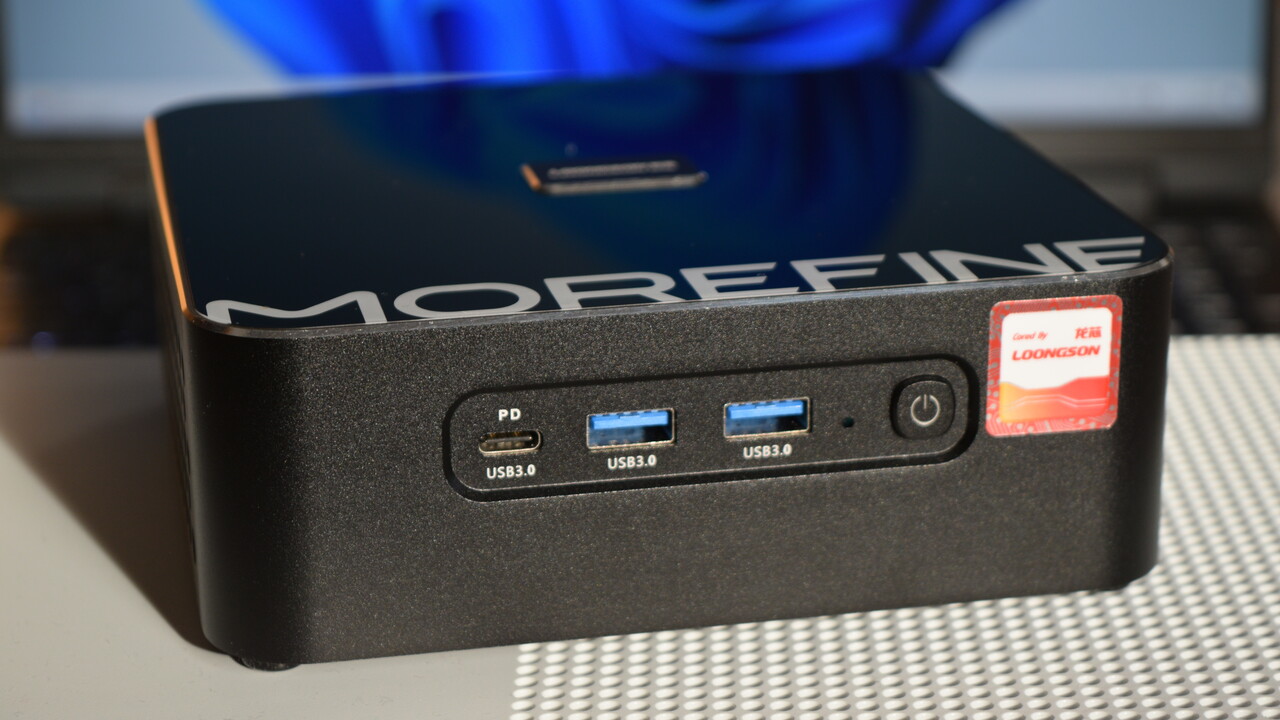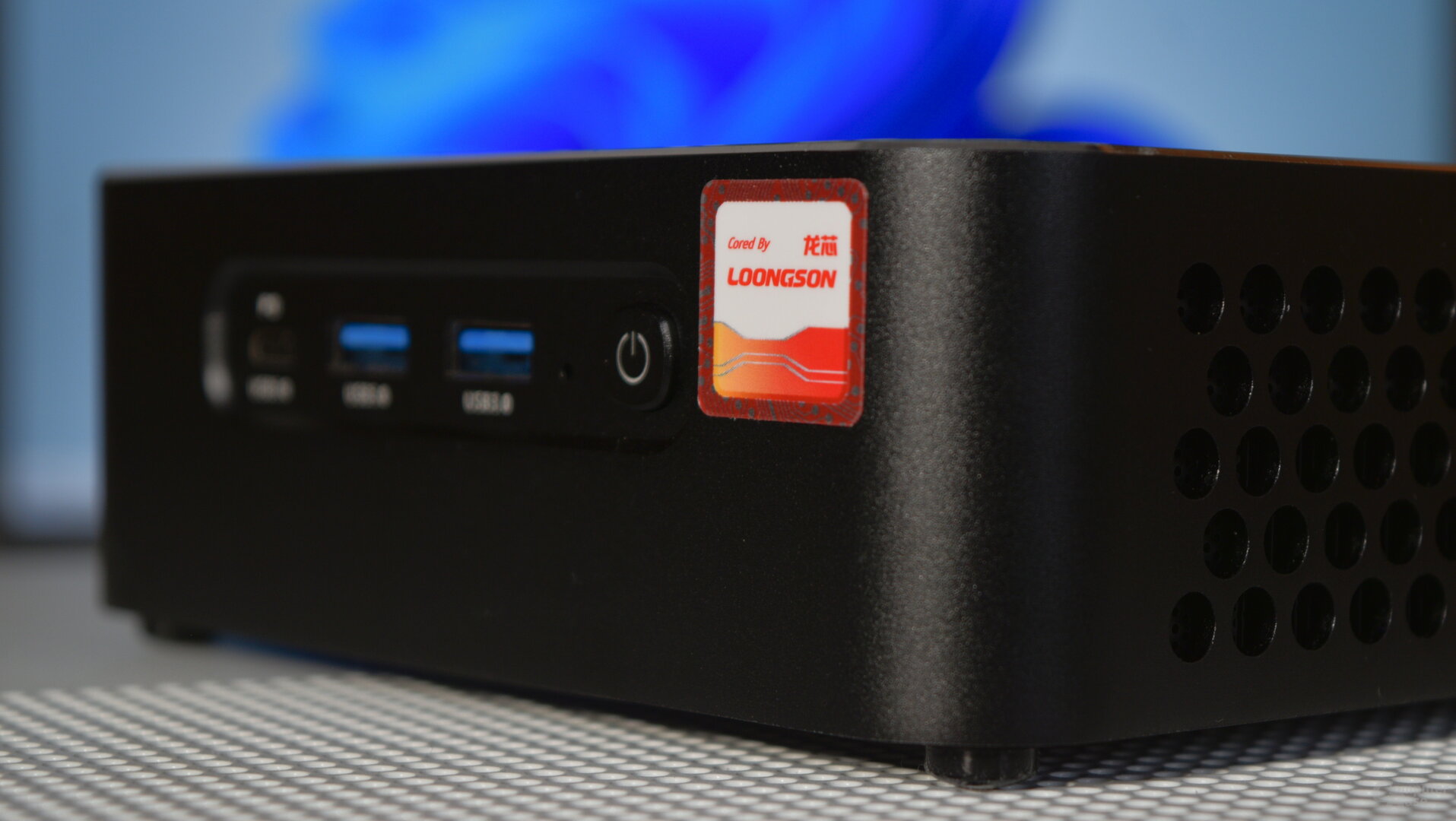Loongson CPU in the test: The mini PC with the Chinese processor in the benchmark 137 comments

China’s early in-house processor developments cast longer and longer shadows. After Zhaoxin’s x86 CPUs, the Morefine mini PC uses a Loongson CPU with its own architecture, entirely manufactured in China. Techconseil tested the processor of Morefine’s mini PC in China and created numerous benchmarks.
Table of contents 1 The mini PC with the Chinese processor in the benchmarkChina needs more risk-free processors The MIPS architecture at a glance Loongson chip developer at a glance Morefine with the Loongson 3A6000 in the test 2 Benchmarks and ConclusionStreaming on YouTube MotionMark Speedometer JetStream 2 Wrapping Program 3.0 Phoronix 7-Zip Test Suite Conclusion Update November 29, 2024 11:25 a.m.
Techtip reader Chithanh pointed out that the “LoongArch” architecture, which underpins the Loongson processor, is no longer officially based on the MIPS architecture, but is believed to be an internal development. Relevant text passages have been updated.
However, Tom’s Hardware noted as early as 2021 that the pieces of code the company uses to enable its own processors are identical to previous code intended for Loongson’s older officially MIPS-based processors.
Although Loongson claims that its latest 3A5000 and 3C5000 processors are based on its own proprietary architecture and are no longer based on the MIPS architecture, the code the company uses to enable the new processors in Linux is actually the same code as it used for its MIPS based processors. chips.
Anton Shilov, Tom’s Hardware
China needs more processors without risk
The People’s Republic of China wants and must become more independent in terms of computer technology. This applies not only to GPUs, as the import of Nvidia and AMD products is becoming increasingly difficult due to US sanctions, but also to CPUs. x86 and Arm or the rights to the architectures have long no longer been a safe bet when owned by Western companies and licensed to Chinese companies.
Single manufacturer with x86 license
The only Chinese manufacturer currently with an x86 license is Zhaoxin. Behind this is a joint venture between Via Technologies and the Shanghai municipal government, in which the Chinese state holds the majority of shares.
The latest developments are the KX-6000 and KX-7000 series, the latter of which already supports DDR5. Even against older entry-level processors from AMD and Intel, these models don’t stand a chance in terms of performance.
Businesses rely on RISC-V or MIPS
RISC-V and now also MIPS CPU architectures are available free of charge; there is no licensing model that could be subject to sanctions. The manufacturer Loongson has used MIPS since 2002. After several changes of ownership, the MIPS architecture has been open source since 2019.
MIPS architecture at a glance
MIPS stands for Microprocessor without Locked Pipeline Stages.
This architecture was developed in the early 1980s and gained popularity through its use in Silicon Graphics International (SGI) workstations, as almost all blockbuster CGI films of the 1990s were rendered on corresponding computers.
Loongson chip developer at a glance
Loongson was originally a working group of the Chinese Academy of Sciences, founded in 2001, whose first chip was the X1A50 processor. As early as 2003, the move from 32-bit to 64-bit processors was made, with the maximum clock speed of 1.0 GHz being much lower than the clock speeds of the AMD Athlon XP and Intel Pentium IV at at the time, which were 2.2 GHz. and 3, respectively. 0 GHz offered.
In order to avoid legal problems with MIPS Technologies, four controls were initially missing whose patents were still held by MIPS, so Loongson could only speak of a similar, but not completely compatible, architecture. It was not until 2007 that Loongson acquired STMicroelectronics in a roundabout way and then directly acquired a license from MIPS Technologies in 2009. Loongson’s current MIPS CPU is the Loongson 3A6000, which was used in the Morefine mini PC for this test . A note on this: As for the architecture called LoongArch, Loongson says that it is a completely internal development. It is difficult to estimate the extent to which the remaining MIPS are still used. At least, according to the manufacturer, these CPUs are MIPS-64 compatible and offer the ability to run MIPS-compliant software with 100% efficiency. On Arm it would still be 90%, while x86 falls further behind and shows 80% efficiency on Linux and 70% on Windows. At least that’s Loongson’s numbers.
Morefine with Loongson 3A6000 in the test
Morefine also offers mini PCs equipped with AMD or Intel processors and only sells them in Germany. If you want to own a Loongson model, you must import it via a detour.
The Loongson 3A6000 in details
The performance of the 3A6000 CPU would be at the level of Western x86 technology of 2020 like the Intel Core i3-10100F, the smallest 10th generation Intel Core CPU presented by Intel at the time. Adjusted for clock speeds, the IPC is on par with a Core i5-14600K, Loongson says, but these processors also have a much higher frequency.
 Loongson promises Core i3-10100F level performance using the SPEC_CPU_2006 benchmark (Image: Microcomputer (微型计算机))
Loongson promises Core i3-10100F level performance using the SPEC_CPU_2006 benchmark (Image: Microcomputer (微型计算机))
AppleLoongson is far from the current performance of x86 or Arm processors from AMD, Intel or Qualcomm, but the predecessor 3A5000 is ultimately sufficient for school or office desktops and is not wrongly used in some establishments teaching in China.
The main technical data of Loongson processors at a glance Processor model Architecture Manufacturing Cores/threads Clock L1 L2 L3 Cache RAM (type + clock) GPU TDP publication 3A5000 LA464 14 nm 4/8 2.3 – 2.5 GHz 64 KB + 64 KB 256 KB 16 MB DDR4-3200 dual channel (ECC) unknown 35W 2021 Core i3-10100 Comet Lake 14nm 4/8 3.6 – 4.3GHz 64KB 256KB 6MB Dual Channel DDR4-2666 UHD 630 65W 2020 Snapdragon 850 Kryo 385 10nm 4+4/8 1 , 8 + 2.95 GHz total. 768 KB 1.5 MB 2 MB – Adreno 630 approx. 4.7 W 2018 3A6000 LA664 12 nm 4/8 2.0 – 2.5 GHz 64 KB + 64 KB 256 KB 16 MB DDR4-3200 dual channel (ECC) external 38 W 2023 3B6600 LA864 7 nm 8/16 3. 0 – 3.5 GHz – – 16 MB – LG200 (?) – 2025
The Morefine Mini PC at a glance
Morefine’s compact mini PC offers two USB-A ports and one USB-C port on the front, the latter also supporting Power Delivery. On the back are four more USB-A ports, two HDMI and two LAN ports. A 3.5mm jack and the connector for the power supply are also located here.

Morefine Mini PC: Front image 1 of 2
At least for the author of these lines, the HDMI ports regularly refused to work. On the home KVM switch with an HDMI to DVI adapter, the mini PC only produces an image as long as Linux has not yet started. On the TV with native HDMI, only the bottom one worked under Linux etc., the top one only worked on the splash screen and in BIOS.
Inside you will find the cooler with an 80mm fan, under which the CPU and a chipset with GPU as well as two DDR4 chips are hidden.
Next to it you can see the slot for the NVMe SSD according to PCIe 3.0 x4. The SSD itself comes from ZhiTai, a brand of Chinese NAND developer YMTC, and uses the parent company’s Xtacking technology, while the DDR4 DRAM cache comes from Nanya. Like VIA Technologies, Nanya is owned by Taiwan’s Formosa Plastics Group.
The PC’s cooling system only responds with a noisy fan at startup, but remains relatively quiet when idle. However, as soon as the load is applied, the fan turns on audibly and with an ominous buzzing sound, reports Techoutil community member Betonor, who purchased the mini PC pictured in the article.
Longsoon does not work on Windows
Not only the processor manufacturer and the processor instruction set, but also the operating system used on the mini PC do not match the usual picture.
Unlike Zhaoxin x86 processors, Loongson processors are not compatible with current Windows because Windows CE was the last operating system from Redmond to officially support the older MIPS architecture.
 Loongson: The LoongNix Linux distribution office
Loongson: The LoongNix Linux distribution office
The processors are said to be able to process x86 code, but one concrete community member already had problems installing a Linux variant other than the preinstalled one – a Linux with a mix of Chinese and English is used from the factory, what is the case in this country is difficult to use. On Windows, the installation process started but could not be completed.
Currently supported are NetBSD, OpenBSD and in this case a custom Linux called LoongNix. The latter offers everything you need to perform simple office tasks. This includes its own browser as well as derivatives Word, Excel and Paint and the famous Solitaire and Minesweeper are also pre-installed.
Even though Windows cannot be used on this device, x86 programs such as the Firefox browser still run on this system – emulated and therefore at a lower speed.
Page 1/2 Next page
Benchmarks and Conclusion Topics: PC Systems Mini PC Processors Image Preview

Marc deciphers processors by testing their performance for gaming, content creation, and artificial intelligence.


